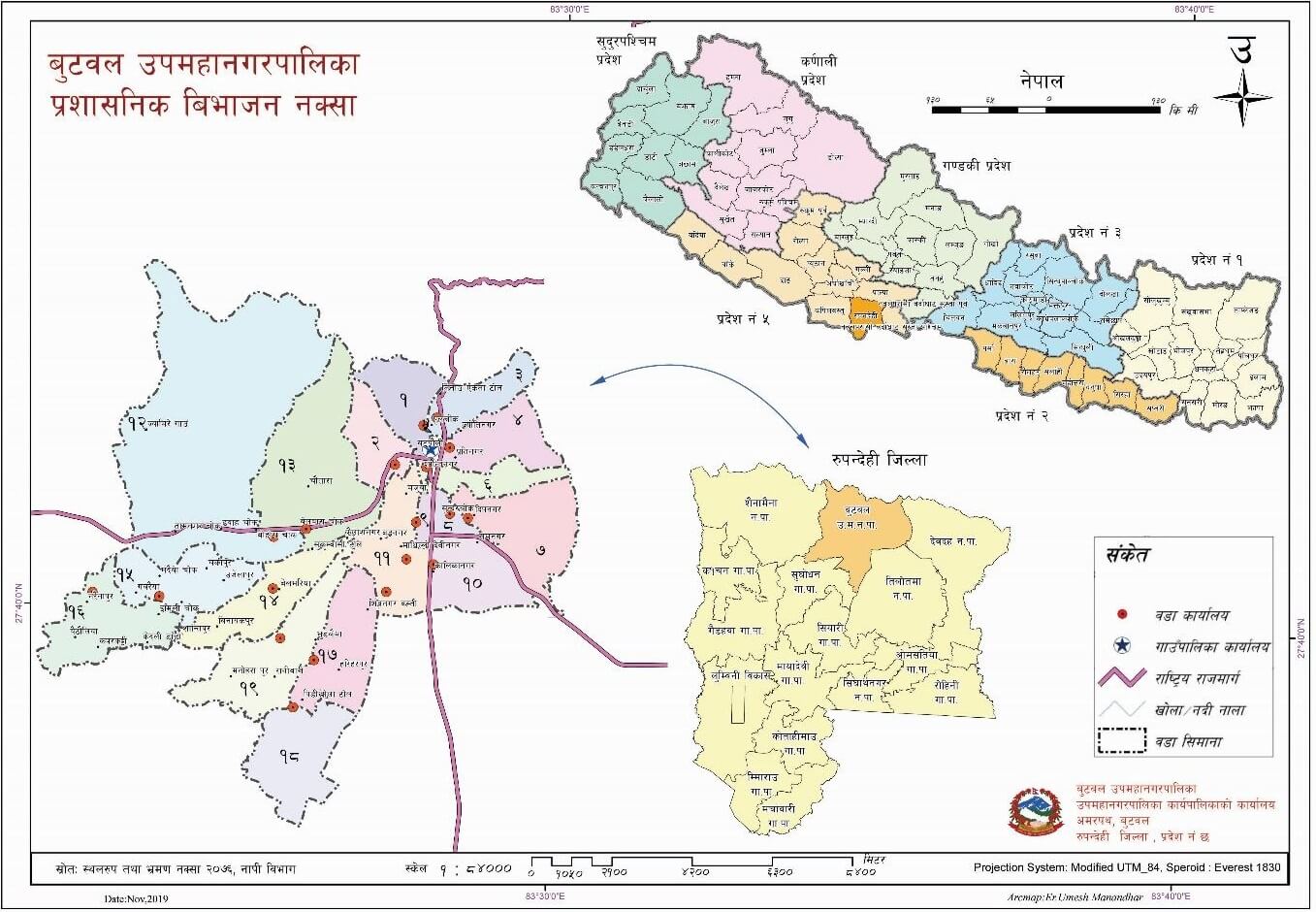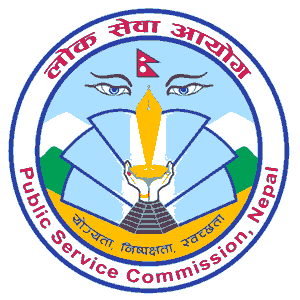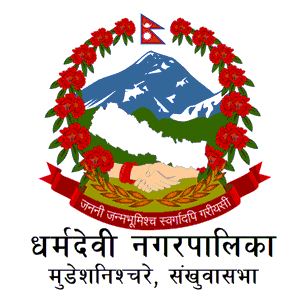Overview
One of the oldest municipalities in Nepal, Butwal Sub-Metropolitan City (Butwal Upa Mahanagarpalika) is located in Rupandehi district of Lumbini Province. Situated at the junction of two major highways of the country, the East-West Highway and the Siddhartha Highway, this sub-metropolitan city was established in 2016 BS. On 16th Mangsir 2071 BS, Butwal Municipality was upgraded to Butwal Sub-Metropolitan City by the Government of Nepal, Ministry of Federal Affairs and Local Development. It is bordered by Devdaha Municipality to the east, Sainamaina Municipality to the west, Tinau Rural Municipality of Palpa district to the north, and Tilottama Municipality and Suddhodhan Rural Municipality to the south.
Situated on the banks of the Tinau River, Butwal has recorded a maximum temperature of up to 45 degrees Celsius and a minimum temperature of 7 degrees Celsius. As the administrative headquarters of the Lumbini Zone, the population within Butwal Sub-Metropolitan City is approximately 150,000. According to the 2078 BS census, the total population of this area is 194,335, of which 94,849 are males and 99,486 are females.

Historical Background and Naming:
Butwal Sub-Metropolitan City is named after the historic and commercial center of Butwal Bazaar. The present-day Butwal Bazaar was once known as 'Batouli.' Since ancient times, Batouli served as an important market for the trade of products from the hills, including Palpa, as well as products from the Terai region. Delving deeper into history, it is estimated that during 581 - 461 BC, King Suddhodhana ruled in Kapilvastu. His son, Siddhartha Gautama, later became the founder of Buddhism. At that time, the current Butwal area was likely a significant part of the Kapilvastu state under the Shakya Republic. After the Shakya dynasty, when the Mughals invaded India, Nutha Raisen, who fled, established the Sen dynasty and developed Batouli Bazaar as a vital part of the Palpa state.
During the unification campaign of Nepal, on the 20th of Jestha, 1861 BS, the Gorkhali army captured the palace of King Prithvipal Sen of Srinagar, bringing the present-day Butwal under the Palpa state into the unified Nepalese state. After the unification, the British rulers in India, under the pretext of forged documents and with the condition of paying taxes to the Nawab of Bengal, claimed that the Sen kings had given them land to enjoy and established a police station in Butwal to administer the area. However, the then Prime Minister Bhimsen Thapa could not tolerate this. Although nobles like Balbhadra Kunwar and others advised Bhimsen Thapa to cede 22 villages of Rautahat to the British in exchange for saving Butwal, Bhimsen Thapa refused. His argument was that the British would enter as a needle and return as a spear, which would endanger Nepal's existence. He thus prepared for war with the British. Following this decision, under the leadership of Maniraj Faujdar, military forces from Palpa arrived, expelled the British from Butwal and Siuraj police stations, and administered the area. Immediately, the British Governor Lord Hastings unilaterally declared war. On Nepal's side, Colonel Ujir Singh Thapa, the chief administrator of Palpa, fortified Batouli Fort (Jitgadhi Fort) and stationed troops there. When around four thousand British troops led by General Suleiman Wood advanced towards Jitgadhi along the Tinau River, the Nepalese troops fired at them, wounding Major Hyat and Engineer Lieutenant Morrison, which forced the British troops to retreat. Again, in the first week of Baisakh 1872 BS, when the British troops attacked Jitgadhi from Khasyouli, the Nepalese troops opened fire, resulting in significant casualties among the British forces, who then fled. Thus, Batoulighadi became known as Jitgadhi. The Jitgadhi Fort, which defeated the imperialist British army that had never been defeated anywhere in the world, has written a glorious tale of valor, courage, bravery, and patriotism. Today, Jitgadhi remains an important historical heritage of Butwal Sub-Metropolitan City.
There is no unanimous opinion among scholars about how Batouli Bazaar got its name. Some argue that as people from the Himalayas, hills, Terai, and even across the borders gathered and congregated here, the name 'Batouli' evolved. According to another view, the maternal home of Gautam Buddha's mother, Maya Devi, was in Devdaha, located to the east of present-day Butwal. Since Butwal is close to Buddha's maternal home, it is said that the name evolved from 'Buddhaballi' to 'Batouli' over time. Additionally, since ancient times, people from the hills would descend to the Terai, and those from the Terai would travel to the hills and the Himalayas for various purposes. These travelers were known as 'Batuwa.' The village where 'Batuwa' resided was called 'Batuwa Wal' or 'Batuwa Wali.' As these gatherings of 'Batuwa' continued over time, the name may have evolved into 'Batouli.' Some also believe that the name 'Batouli' came about because it was a commercial center and a place where goods were gathered.
Batouli Bazaar was once confined to the western bank of the Tinau River. The market area on the eastern side of the Tinau was known as Khasyouli. The present-day Butwal encompasses both the eastern and western areas of the Tinau River, covering a vast area. Based on available information, the history of Butwal dates back to the dawn of human civilization. Around 2037 BS, a joint team from America and Nepal conducted research and found the tooth of an ancient human species, Ramapithecus, which dates back to approximately ten million years ago, on the banks of the Tinau River near the Siddhababa Temple area. This fossilized tooth, embedded in rock, is the third oldest primitive human relic found in the world, following discoveries in Kenya and Pakistan. This clearly shows that Butwal has been in existence since the early stages of human evolution. The activities carried out here indicate that Butwal is on its way to becoming a model city of Nepal.
Topographical Conditions (Nature of Land Surface, Slope, and Elevation)
When preparing the details of the physical conditions of a sub-metropolitan city, it is essential to mention its topographical features. Despite its small size, Nepal is considered one of the most diverse countries in the world in terms of topography. The formation of the Himalayas, especially during the recent geological processes, was the result of the collision between the Tibetan Plateau and the Indian subcontinent, which led to the disappearance of the Tethys Sea and the creation of the high Himalayan mountain range, the middle Mahabharat range, and the low Chure range. The southernmost region of the country is part of the vast Gangetic plains, known as the Terai. The overall land surface of the country is composed of these distinct geographical features, and one or another of these types of topography is predominant in our sub-metropolitan, rural, or municipal areas.
Topographical features play a crucial role in development and construction. Under topographical details, aspects such as slope, aspect (direction), elevation, land cover, and soil composition are considered essential factors.
Butwal Sub-Metropolitan City, according to its new structure, is located in the Terai district of Rupandehi under Lumbini Province. Although the area is mostly south-facing, the terrain also faces east, west, north, and south. Being part of the Mahabharat range, the higher regions have rocky and sandy soil. As the terrain descends, clayey soil is found, which is very suitable for agricultural production.
Land Use Details:
The creation of human civilization and human life is fundamentally based on the utilization of natural resources available on the Earth's surface. All human activities are entirely dependent on the land they use and the resources available on that land. Therefore, under land cover, statistics related to the forests, arable land, water bodies, sand, mountains, hills, etc., that humans utilize are included under land use. The land use details of Butwal Sub-Metropolitan City are as follows.
When looking at the current land use of this sub-metropolitan city, forests occupy the largest portion, covering 48.55% of the area. The second-largest land use is arable land, which covers 23.65%. Having more than 40% of the total land area as forest is favorable from an environmental balance perspective. However, it is essential that this forest area be fully utilized and managed scientifically. The portion of arable land is also significant, and if scientific agricultural practices are implemented, there is a good potential for increased productivity.
Another notable aspect of land use in this sub-metropolitan city is the percentage of land covered by shrubs, bushes, and wasteland, which occupies 1.18% of the total land area. The residential area occupies 19.57% of the land. Sand and riverbank areas cover 5.49%, while water bodies occupy a minimal portion, accounting for just 1.35% of the total land area.
Cultural Characteristics:
Human behavior, language, and lifestyle are guided in an intangible manner by certain traditions. To conduct daily activities, individuals are bound within the structures of family and society. Traditions such as marriage establish relationships, which lead to the creation of families. All activities related to birth, death, marriage, food habits, clothing, festivals, language, and lifestyle fall under cultural characteristics. These dimensions of civilization and culture are key aspects of an individual's identity. Cultural activities help people lead a refined life and organize and energize society.
In Butwal Sub-Metropolitan City, 94.85% of the population follows Hinduism, with 30.80% belonging to the Brahmin Pahadi community. The main festivals celebrated here include Dashain, Tihar, Lhosar, Buddha Jayanti, and Holi. Festivals like Saune Sankranti and Maghe Sankranti are also celebrated with special significance by the local populace. The major rituals observed by the Hindu community include Kul Puja, Goth Puja, Bratabandha, Marriage, Death Rites, Annual Ceremonies, Naming Ceremony, Shraddha, Sohra Shraddha, Amavasya, Purnima, Sankranti, Masant, Satyanarayan Puja, Ekaha, Homam, Yagya, Saptaha, Rudri Path, Malamas, Solar and Lunar Eclipses, among others. Festivals like Eid celebrated by the Muslim community and Christmas celebrated by Christians are also popular.
Butwal Sub-Metropolitan City is home to people from various ethnicities, religions, and cultures. Each community has its own unique religion, culture, and customs. Traditional attire in this area varies by gender and ethnicity. Women typically wear sarees, blouses, and kurta-suruwal. Men from the Chhetri, Brahmin, Kami, and Damai communities often wear shirts, suruwals, and daura-suruwals, while the Magar and Newar communities wear chaubandi cholo, lungi, and patuka around the waist. However, in modern times, youth from all communities increasingly prefer to wear pants, shirts, T-shirts, sarees, blouses, kurtas, and salwar suits.
Main Development Possibilities:
Every location has its unique characteristics. Some areas have extensive forested land, while others have abundant water resources or are classified as dry regions. Therefore, agricultural areas can achieve growth through the commercialization of agriculture, and localities with extensive forest areas can attain prosperity through scientific forest management. Overall, the potential of a sub-metropolitan city can be highlighted based on the available resources and assets.
Butwal Sub-Metropolitan City, with 48.55% of its area covered by forests, holds significant potential for achieving prosperity through scientific forest management. Scientific forest management involves caring for and improving forests, treating them like crops. In this sub-metropolitan city, the opportunities for development and potential include traditional and modern agriculture, herbal medicine, tourism, livestock farming, and the development of small and medium industries. Additionally, there are ample opportunities to develop parks, gardens, monasteries, and stupas in various parts of the sub-metropolitan city, transforming them into tourist attractions.
In terms of land use, Butwal Sub-Metropolitan City is characterized by a high number of families engaged in industry, wholesale and retail trade, hotels, service-oriented businesses, and salaried professions in urban areas. In contrast, the rural areas of the sub-metropolitan city have a higher number of households engaged in agriculture. There are ample opportunities to increase production of food grains, cash crops, vegetables, fruits, spices, and herbal and livestock products on the arable land within the sub-metropolitan city. However, due to the lack of modern agricultural technology, fertilizers, and tools, and their high costs, agricultural production has not increased as needed. By enhancing public awareness, skills, commercialization, modernization, technology transfer, and simplifying the availability of necessary technology, fertilizers, credit, and seeds, there are ample possibilities to improve economic conditions through increased agricultural and livestock production.
The highly fertile land within the sub-metropolitan city has not been fully utilized due to unplanned settlement development, climate change, global warming, and the lack of modern agricultural systems. Moreover, soil fertility is gradually declining, leading to reduced production and productivity. If unplanned settlements can be organized, and traditional irrigation channels can be repaired and improved to increase soil fertility, the sub-metropolitan city can be developed as a livable place for future generations.
The rural areas of the sub-metropolitan city have great potential for dairy production and livestock farming. Expanding this industry and extending accessible transportation services to these areas would enable the development of milk chilling centers, agricultural production collection centers/cold stores, and meat processing industries in many places. This would create employment opportunities and increase the overall income of the sub-metropolitan city.
If the natural resources and assets of the sub-metropolitan city are managed properly and environmentally friendly technology is adopted, these areas could create local employment opportunities in some rural areas and bring sustainability to the mobilization of local resources. Given the presence of natural rivers and streams within the sub-metropolitan city, constructing ponds and artificial lakes in other potential areas for fish farming suitable to the climate of this region could easily increase job opportunities, and locally produced fish could capture the market. Organizing and institutionalizing the community forest user groups within the sub-metropolitan city to promote non-timber forest products like herbal farming and honey production could further support the area's economic development.
This sub-metropolitan city, rich in various historical, religious, cultural, and archaeological sites, boasts heritage like Jitgadhi Fort, Mani Mukundsen Park, Fulbari, Hill Park, and several temples within the city. If these sites can be organized, there is potential to attract both domestic and foreign tourists, creating additional economic opportunities.
The cultural and traditional customs of the various ethnic groups in Butwal, including their festivals and dances, also contribute to the city's tourism potential. Performances such as the Ghatu dance and Sorathi dance by the Magar and Gurung communities, the Lakhe dance and Gai Jatra of the Newar community, the Shelo of the Tamang community, the Rodi Ghar of the Gurung community, and the Balun and Sangini dances of the Chhetri and Brahmin communities make Butwal Sub-Metropolitan City an important cultural hub.
As unemployment rises in the country, and with limited job opportunities in the government and non-government sectors, the attraction to foreign employment has increased. By providing skill-based training to the youth of this sub-metropolitan city and creating local employment opportunities, there is ample potential to contribute significantly to the economic development of the sub-metropolitan city.
In addition to these opportunities, the following potential measures can be highlighted for the development of Butwal Sub-Metropolitan City:
-
By irrigating water from sources and streams within the sub-metropolitan city through modern irrigation channels and canals, agricultural production can be significantly increased.
-
Implementing a 'one household, one tap' policy through a mega drinking water project from local water sources could reduce the drinking water problem currently faced by the sub-metropolitan city and provide irrigation facilities.
-
Upgrading and blacktopping local dirt roads would enhance local residents' access to services, improve living standards, and enhance the overall beauty of the sub-metropolitan city.
-
Expanding industrial development within this area would create ample job opportunities at the local level.
-
Given the presence of various historical, religious, and cultural sites in this area, there is significant potential for tourism development.
-
With the involvement of governmental, non-governmental, and private organizations in this area, there is potential for partnerships in the development of the sub-metropolitan city.
-
With the increasing consumer base in the sub-metropolitan city area, there is potential for the development of industry, trade, and commerce.
Inter-Municipal/Sub-Metropolitan Relationships:
There is always some form of relationship between local governments (municipalities), and the nature and distance of these relationships can vary between municipalities. For human development, people need to move between different places, and in the process of utilizing and mobilizing available resources, one municipality may rely on another. The main areas of interdependence include transportation, migration, agricultural and livestock markets, forest products, tourism, employment, natural resource utilization and management, education, and health.
Additionally, this sub-metropolitan city has a good relationship with neighboring municipalities/rural municipalities and other governmental bodies such as the District Coordination Committee. As a result, there is effective coordination in the execution of developmental activities in the region. Butwal Sub-Metropolitan City shares geographical, cultural, and social ties with all the municipalities and rural municipalities along its borders. Similarly, it maintains strong relationships with various national and international non-governmental organizations.
Geographical Area:
- Province: Lumbini Province
- District: Rupandehi
- Municipality: Butwal
- Year of Establishment: 2016/11/3 BS
- Number of Wards: 19
- Area: 101.613 sq. km
Population:
- Total Population: 195,054
- Total Male Population: 95,705
- Total Female Population: 99,349
- According to the National Census of 2078 BS
Boundaries of Butwal Sub-Metropolitan City:
- East: Devdaha Municipality, Rupandehi
- West: Sainamaina Municipality, Rupandehi
- North: Tinau Rural Municipality, Palpa
- South: Suddhodhan Rural Municipality and Tilottama Municipality, Rupandehi
Temperature:
- Minimum Temperature: 8°C
- Maximum Temperature: 45°C
Main Ethnic Groups:
Brahmin, Chhetri, Newar, Gurung, Magar, Thakuri, Tharu, Thakali, etc.
Religion:
Hindu, Buddhist, Muslim, Sikh, Christian, etc.
Important Religious Sites:
Siddhababa, Ganesh Temple, Narayansthan, Radhakrishna Temple, Kalika Temple, Ram Temple, Bhuvaneshwari Temple, Buddhist Stupa, Padma Chaitya Bihar, etc.
Historical Sites:
Ramapithecus Fossil Site, Jitgadhi Fort, Manimukunda Sen Palace, etc.
Tourist Sites:
Manimukunda Sen Park, Hill Park, etc.
Hospitals:
Lumbini Provincial Hospital, Siddhartha Child and Women Hospital, Lumbini Ayurveda Hospital, Lions Eye Hospital, Lumbini Nursing Home, Butwal Hospital Pvt. Ltd.




